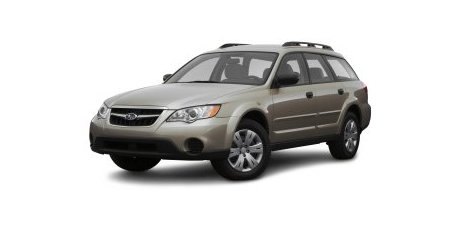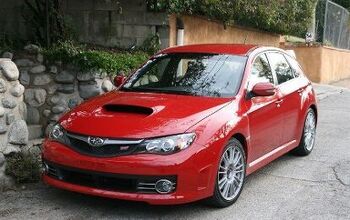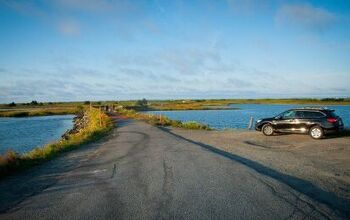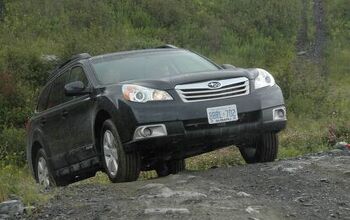2008 Subaru Outback Review
Station wagons with manual transmissions are quickly going the way of the fedora. In fact, there are more gas-electric hybrids for sale stateside than row-your-boat wagons. If you want an all-wheel-drive model, the number plummets. Which makes me wonder: what's the point of the Subaru Outback five-speed?
Although I can't speak for Subie's Sapphic fans, sex appeal is NOT the Outback's raison d'etre. Oh, it's handsome enough; in a stern, trim, no grotesque affectations sticking you in the eye sort of way. Subaru's raised the beltline (to lose the Popemobile effect), added new lights (there was a sale on Japanese fish eyes) and stuck a Chrysler Pacifica logo on the snout. While the Outback now looks more expensive than it is, it's about as quirky as an accountant wearing different colored socks.
The interior is equally enthralling and twice as sensible. Fold down the Outback's rear seats and lifestyle load luggers enjoy almost as much schlepitude as Volvo's V70. Although Subaru's redesigned the Outback's instrument panel, "revised" the interior fabrics, added a telescoping wheel (yay!) and numbered the radio buttons from one to five, the cabin remains very much of a muchness. There's nothing tasteless, nothing tasty. Well, except for the meaty steering wheel…
The helm puts you in charge of Subaru's 170hp 2.5-liter SOHC aluminum-alloy 16-valve horizontally opposed four-cylinder engine. If Porsche went all Jaguar on us and tried to dip down market, this is the kind of engine I'd expect: smooth, free-revving and just about as gutsy as a four can be. But Outback drivers are never in any doubt that they're lugging around a couple hundred extra pounds of all wheel-drive (AWD) gear.
The Outback's ride is comfortable without the slightest hint of refinement. Dry road handling is exemplary, with predictable body roll and enough steering feel to tell you when to quit (early and often). Try to accelerate out of a couple of turns and the Outback's architecture tells you that the vehicle could stand another 80 horses– and the rest. The no-fun factor might be considered a plus in a wagon full and kids and dogs and things to be inflated, but it's a definite drawback when you're all alone and late for work. And then…
I was fortunate enough to test our base Outback on fresh powder and packed snow. The worse the conditions, the better it got.
Needless to say, I developed an immediate and intimate respect for Subaru's time-honed Symmetrical AWD system. While other drivetrain layouts have all kinds of 90 degree kinks to sap power and response, the Outback's in-line engine allows more direct power transfer to all the wheels. At the same time, the low-slung boxer engine provides a lower center of gravity, like bending your knees when you're skiing.
The Outback's four-wheel disc brakes, with ABS and electronic brake-force watching over each wheel, proved highly effective on the white stuff. More to the point (of the vehicle's existence), when traction is iffy, it's nice to have more options than merely stop and go. The Outback's manual transmission gives the set up more feel. Sure, you can crank the automatic's lever back and forth, but it's not the same as feathering the clutch, whipping up the revs or using the engine as a brake.
Taken as a whole, the Outback bites, rather than slides on, the snow; it felt like I had an invisible keel slicing through an unseen slot in the road. Although it doesn't have all the toys and [much of any] torque, the entry level Outback has still got the bad weather integrity that makes it an entirely justifiable for people who live in the… wait for it… outback.
Again, if you live in those parts of the country where you can get to grandma's house sans icy winds and killer snow drifts, and you're not likely to travel for hours on unpaved roads, the Outback is a different beast. Well, maybe "beast" is the wrong word. A different "animal:" one of those zoo dwellers that's odd but not terribly attractive. Though it's still adept at negotiating wet leaves, large puddles and the occasional hopped curb, the Outback's charms diminish in direct proportion to the civility of your driving environment.
The number of American drivers who favor a manual transmission is in the single digits and falling fast. But Subaru's right to continue offering a stick shift, low frills, Outback with a relatively anemic engine.
What's the reverse of a halo car? You know: a car that shows that a brand is still in touch with the austere competence that endeared its products to its original financially-challenged, mechanically savvy customers? The five-speed manual base Outback is it. Well done to Subaru for not pulling-up its roots. Now, if they could just strip and flip the STI…
More by Michael Martineck
Latest Car Reviews
Read moreLatest Product Reviews
Read moreRecent Comments
- Ltcmgm78 It depends on whether or not the union is a help or a hindrance to the manufacturer and workers. A union isn't needed if the manufacturer takes care of its workers.
- Honda1 Unions were needed back in the early days, not needed know. There are plenty of rules and regulations and government agencies that keep companies in line. It's just a money grad and nothing more. Fain is a punk!
- 1995 SC If the necessary number of employees vote to unionize then yes, they should be unionized. That's how it works.
- Sobhuza Trooper That Dave Thomas fella sounds like the kind of twit who is oh-so-quick to tell us how easy and fun the bus is for any and all of your personal transportation needs. The time to get to and from the bus stop is never a concern. The time waiting for the bus is never a concern. The time waiting for a connection (if there is one) is never a concern. The weather is never a concern. Whatever you might be carrying or intend to purchase is never a concern. Nope, Boo Cars! Yeah Buses! Buses rule!Needless to say, these twits don't actual take the damn bus.
- MaintenanceCosts Nobody here seems to acknowledge that there are multiple use cases for cars.Some people spend all their time driving all over the country and need every mile and minute of time savings. ICE cars are better for them right now.Some people only drive locally and fly when they travel. For them, there's probably a range number that works, and they don't really need more. For the uses for which we use our EV, that would be around 150 miles. The other thing about a low range requirement is it can make 120V charging viable. If you don't drive more than an average of about 40 miles/day, you can probably get enough electrons through a wall outlet. We spent over two years charging our Bolt only through 120V, while our house was getting rebuilt, and never had an issue.Those are extremes. There are all sorts of use cases in between, which probably represent the majority of drivers. For some users, what's needed is more range. But I think for most users, what's needed is better charging. Retrofit apartment garages like Tim's with 240V outlets at every spot. Install more L3 chargers in supermarket parking lots and alongside gas stations. Make chargers that work like Tesla Superchargers as ubiquitous as gas stations, and EV charging will not be an issue for most users.


































Comments
Join the conversation
i am buying my first car and a bit nervous. i work in one of america's ports which means: lost of trucks, potholes, junk in the road. i am really concerned about safety. was planning on buying the outback or legacy b.c of it's stellar crash test results (passive safety) and performance (active safety) but saw the consumer reports video showing the fish tailing during emergency handling--also mentioned by kurtamaxxguy. visions of honda accords are filling the void (seriously, the accord did very well in crash tests) wondering if anyone knows if the new legacy will prob fishtail as well? is there a way to find out from someone other than a subaru salesperson?
Oh! Please! An Outback wagon - even with the turbo - hasn't the power-to-weight ratio to fishtail on dry pavement. On slippery pavement any rear-wheel drive car will fishtail. An AWD car will likely do so less because the torque is split between the front and rear wheels as well as side-to-side. Of course, with a front-wheel driver you don't have an option to mash the throttle to help get around a slippery curve and always end up nose first into the snow bank. Yes, you can get a bit of a funny movement out of a manual turbo Legacy sedan if you step off the throttle at high revs and speed in a turn. You won't be getting there in an Outback, though...and certainly not on slippery roadways...you'd have to be crazy or over-libated to drive that fast.